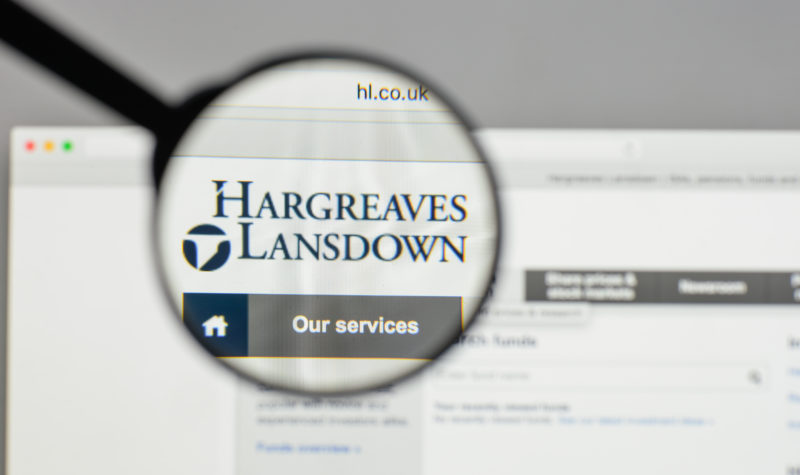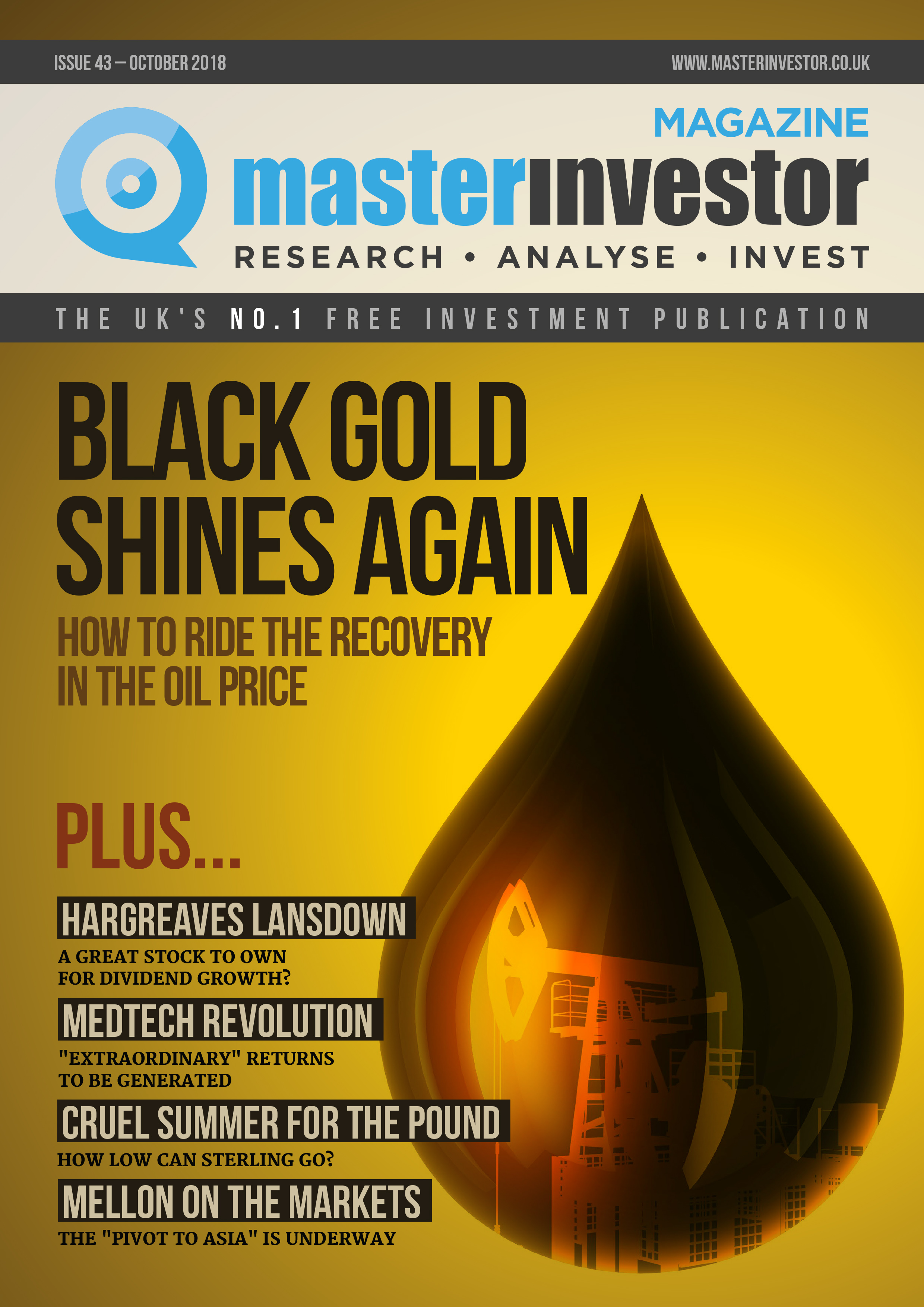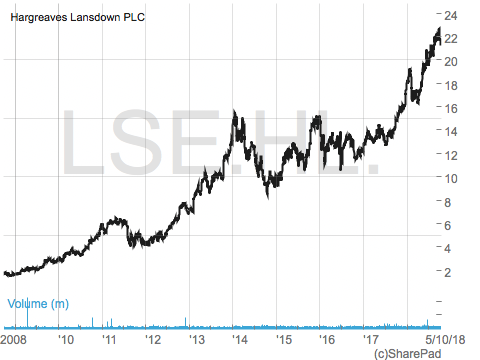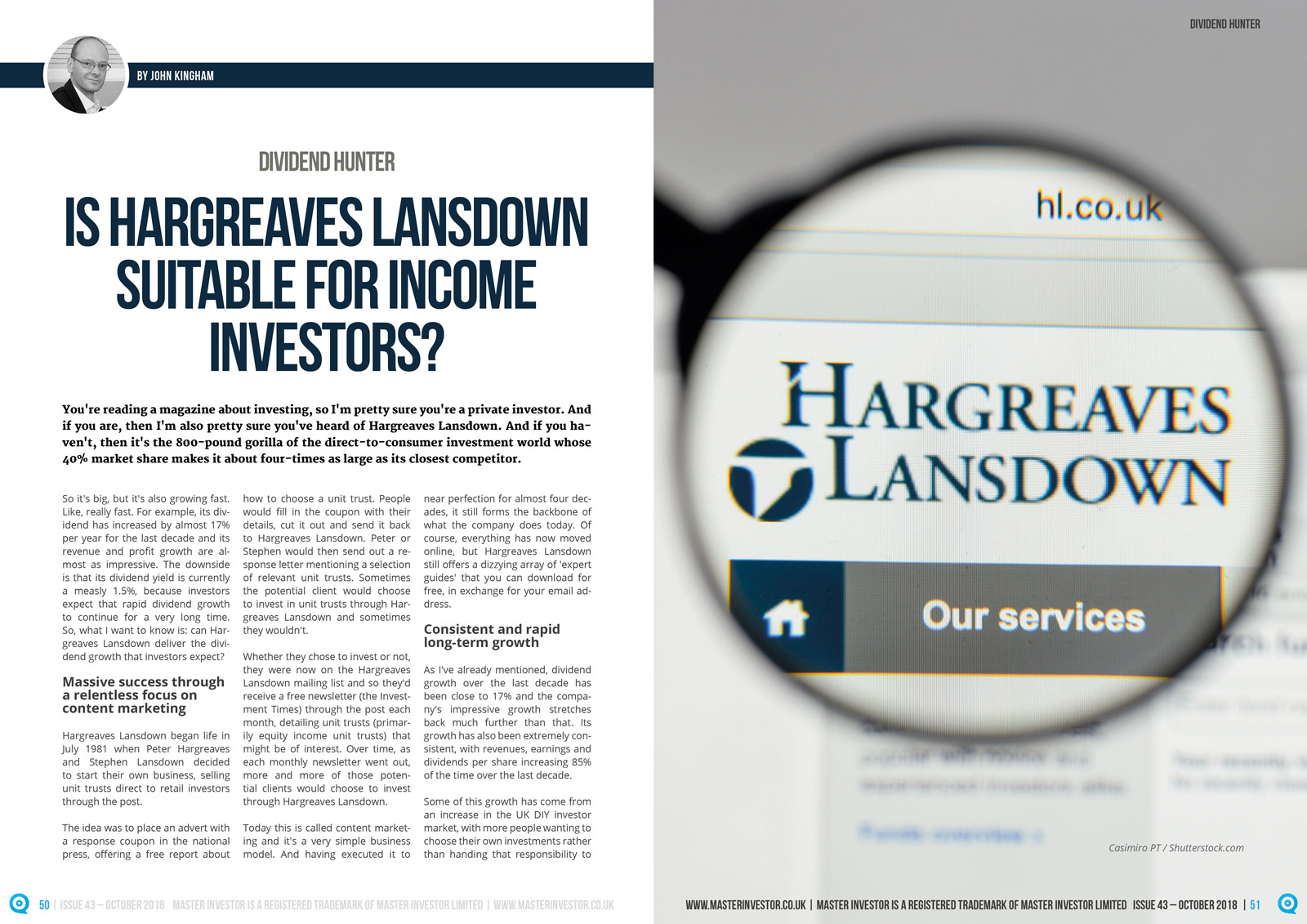Is Hargreaves Lansdown suitable for income investors? – MAGAZINE EXCLUSIVEMAGAZINE EXCLUSIVE

MAGAZINE ARTICLE
This article first appeared in Issue 43 of Master Investor Magazine.
Click here to download the article as a printer-friendly PDF

Get this article and many more – for free! |
You’re reading a magazine about investing, so I’m pretty sure you’re a private investor. And if you are, then I’m also pretty sure you’ve heard of Hargreaves Lansdown. And if you haven’t, then it’s the 800-pound gorilla of the direct-to-consumer investment world whose 40% market share makes it about four-times as large as its closest competitor.
So it’s big, but it’s also growing fast. Like, really fast. For example, its dividend has increased by almost 17% per year for the last decade and its revenue and profit growth are almost as impressive. The downside is that its dividend yield is currently a measly 1.5%, because investors expect that rapid dividend growth to continue for a very long time. So, what I want to know is: can Hargreaves Lansdown deliver the dividend growth that investors expect?
Massive success through a relentless focus on content marketing
Hargreaves Lansdown began life in July 1981 when Peter Hargreaves and Stephen Lansdown decided to start their own business, selling unit trusts direct to retail investors through the post.
The idea was to place an advert with a response coupon in the national press, offering a free report about how to choose a unit trust. People would fill in the coupon with their details, cut it out and send it back to Hargreaves Lansdown. Peter or Stephen would then send out a response letter mentioning a selection of relevant unit trusts. Sometimes the potential client would choose to invest in unit trusts through Hargreaves Lansdown and sometimes they wouldn’t.
Whether they chose to invest or not, they were now on the Hargreaves Lansdown mailing list and so they’d receive a free newsletter (the Investment Times) through the post each month, detailing unit trusts (primarily equity income unit trusts) that might be of interest. Over time, as each monthly newsletter went out, more and more of those potential clients would choose to invest through Hargreaves Lansdown.
Today this is called content marketing and it’s a very simple business model. And having executed it to near perfection for almost four decades, it still forms the backbone of what the company does today. Of course, everything has now moved online, but Hargreaves Lansdown still offers a dizzying array of ‘expert guides’ that you can download for free, in exchange for your email address.

Consistent and rapid long-term growth
As I’ve already mentioned, dividend growth over the last decade has been close to 17% and the company’s impressive growth stretches back much further than that. Its growth has also been extremely consistent, with revenues, earnings and dividends per share increasing 85% of the time over the last decade.
Some of this growth has come from an increase in the UK DIY investor market, with more people wanting to choose their own investments rather than handing that responsibility to an advisor or pension company. However, most of Hargreaves Lansdown’s growth has come by taking market share from its competitors, and, today, the company’s share of the investment platform market is an extremely dominant 40%.
Low capital intensity, high return on capital
Some businesses need to spend lots of money on capital assets before they can make a penny of profit. Some need to build or refurbish shops, factories or warehouses; some need to buy or build equipment which they can then lease or sell; others need to invest in expensive infrastructure such as oil rigs or telecoms networks.
Hargreaves Lansdown doesn’t have to do any of that. When the business was getting started, all it needed was a few desks and phones for its employees and a word processor and printer to design and print newsletters and envelopes. This makes it a capital-light business, which has advantages and disadvantages.
One advantage is that capital-light businesses typically don’t need to borrow to invest in future growth. With a capital-intensive business like BT, if it wants to offer ‘5G’ services it will have to spend untold millions developing and rolling out the infrastructure. And most of the time capital-intensive businesses like BT will borrow that money on the assumption that the new infrastructure assets will produce enough of a return to pay back the debt and still keep shareholders happy.
With Hargreaves Lansdown, all it has to do if it wants to upgrade its website or sell a new unit trust is look at the regulatory implications, write some computer code, train some employees and do some content marketing and advertising (I’m sure there’s more to it than that, but you get the general idea). This all costs money too, but relative to what BT spends to earn the same amount of profit, it’s peanuts.
If a company can combine low capital asset intensity with some degree of pricing power (i.e. compete primarily on factors other than price, such as product or service quality), then the returns on those capital assets can be huge.
In Hargreaves Lansdown’s case, its post-tax return on capital employed (ROCE) has averaged more than 70% over the past ten years. To give you some context, the average return on capital employed generated by consistent long-term dividend-paying UK companies is 10%, so it doesn’t take a genius to realise that Hargreaves Lansdown is a very special and extraordinarily profitable company.
Being an extraordinarily profitable capital-light business may sound like a good thing (and it is), but it does have disadvantages.
One disadvantage is that it’s relatively easy for start-ups to compete against the major players. For example, if you want to compete with BP then good luck with that. You’ll need to hire or buy oil rigs, oil storage facilities, oil refineries, petrol stations and all manner of other very expensive assets. But if you want to sell investments to the public, all you’ll need is a few desks (and in the world of virtual offices you may not even need that), some regulatory permissions, computers and so on. It might cost you a hundred thousand pounds or so to get set up, but it won’t cost you a hundred million.
So, in theory (and I think in practice for the most part), the investment platform market should be highly competitive. But Hargreaves Lansdown’s growth rate and 70% ROCE suggest it may not be competitive enough, and that’s another risk. In this case, the FCA is currently conducting an investment platforms market study, looking at competition issues such as fee transparency and the ease (or lack of) with which clients can switch platforms.
But even with these disadvantages, I would still rather invest in an exceptionally profitable capital-light business than a weakly profitable capital-intensive business any day of the week.
A bullet-proof balance sheet with no debt or pension liabilities
Another attractive feature of Hargreaves Lansdown is that it has no debt or pension liabilities. On the debt side of things, this is a function of the company’s capital-light nature. It doesn’t need to invest in lots of expensive infrastructure to grow, which means it doesn’t have to borrow money from banks to grow.
Having zero debt is good because it makes the company more robust. For example, a large chunk of the company’s revenues come from fees which are charged as a percentage of the assets its clients have on its platform. These assets are often invested in the stock market which, as we know, can go down very quickly when it wants to, and that means those fee revenues could go down very quickly as well. If the stock market crashed and Hargreaves Lansdown had lots of debt or pension liabilities with fixed payment obligations, then its profits could quickly turn to losses. But it doesn’t, so this isn’t a major concern.
An exceptional company, but is the price right for income investors?
Hargreaves Lansdown is clearly an exceptional company. It has basically crushed its competition, repeatedly, for several decades. It also has a long and consistent record of dividend growth, good dividend cover and no debt, so the company is also an attractive candidate for dividend investors.
At the time of writing, Hargreaves Lansdown’s shares are trading for 2,220p, giving the stock a 1.5% dividend yield. That obviously isn’t going to be of interest to high yield purists, but, personally, I like to invest in a range of dividend-paying companies, from slower growth companies with higher yields to higher growth companies with lower yields. For me, it’s the balance of yield and growth that matters, rather than just the yield.
As a ballpark target, I’m after a 10%+ annual return from my investments. So, with a dividend yield of 1.5%, I would need Hargreaves Lansdown to grow its dividend by at least 8.5% each year. For that dividend growth to translate into capital growth, I’d also need the dividend yield to stay the same (i.e. a 1.5% dividend income plus 8.5% capital growth equals a 10% total annual return).
Obviously, that’s a hypothetical situation. The company’s dividend won’t grow at 8.5% per year and the dividend yield won’t stay at exactly 1.5%. All I’m trying to do is highlight the underlying principle, which is that a lower yield must be offset by higher growth (through some combination of dividend and capital growth) if you’re to achieve your desired returns.
So, how likely is it that Hargreaves Lansdown can increase its dividend by 8.5% a year over, say, the next ten years?
At first glance, 8.5% dividend growth seems entirely achievable. After all, the company grew its dividend by almost 17% per year over the last decade, so 8.5% should be child’s play. Well, maybe; but perhaps not. The company only went public in 2007, and, in the first few years, the dividend was doubling every three years. More recently the doubling time has increased to every six years or so, giving a dividend growth rate of around 9%, which is not much more than 8.5%.
So yes, perhaps the dividend can grow by 8.5% over the next decade, but that’s still a very lofty target, even for a company as successful as Hargreaves Lansdown.
And that success is perhaps another barrier to future growth. With a 40% share of its core market, where is all that future growth going to come from?I’m pretty sure that 100% market share is as high as it gets, so it isn’t going to come from market share growth. Okay, so the market for DIY investors is likely to grow and the company can move into other related areas, but expansion into new areas is usually difficult because other companies have already been serving those markets for decades.
So, while it’s possible that Hargreaves Lansdown can grow by 8% or more per year and double in size over the next eight or nine years, it won’t be easy; perhaps it isn’t even likely. But let’s assume the company does pull it off and eight years from now it’s twice as big, with double the dividend. That’s great, but don’t pull out the Champagne just yet. To get a 10% return over those eight years we need two things to happen: 1) the dividend grows by 8.5% per year; and 2) the dividend yield stays the same.
In this imaginary scenario, we’ve hit the first target, but what about the second? Why would the yield still be a lowly 1.5% eight years from now? The answer is that investors would have to be as optimistic about the company’s future growth rate as they are today. In other words, in 2024 (eight years from now when the company is twice as big as it is today), investors would have to expect the company and its dividend to double in size again over the following eight years.
Okay, so now we can see just how optimistic we have to be to accept a 1.5% yield from this company. We have to believe it can grow its dividend at 8.5% (or more) not only for the next eight years, but for the eight years after that as well. We would have to believe that Hargreaves Lansdown can quadruple in size over the next 16 years, even though it already has a 40% share of its core market. That is serious optimism and I am just not that optimistic, at least when it comes to investing.
I think a more likely scenario is that the company continues to grow and perform well, but that its growth rate will gradually decline towards average as the company gets larger and larger. This is the eventual fate of all large companies, especially ones that already dominate their core markets. Given that I have these lower growth expectations, I need a lower price and a higher starting yield before I would consider investing.
My target price for Hargreaves Lansdown
Target prices are not set in stone because the amount you should pay for one company will depend on what else you can put your money into at that moment in time. Having said that, as things stand today, I would very seriously consider investing in Hargreaves Lansdown if its share price fell below 1,200p.
At that price the company would have a dividend yield of 2.7%, which is much closer to the 3.4% yield you can get from a FTSE All-Share tracker. Even this is a somewhat optimistic entry price because it requires a long-term dividend growth rate of more than 7%, assuming you’re aiming for a 10% annualised return, as I am. When you add it up over the years, though, 7% is a lot more achievable than 8.5%.
A 1,200p target price means I’m looking for a 45% decline in the company’s share price and I’ll readily admit that this seems unlikely anytime soon. But you never know. BT has fallen by 50% over the last three years, and Rolls-Royce fell by more than 50% between 2013 and 2015, so even the ‘best’ companies and the ‘safest’ shares can fall a very long way in a short time.

|
Comments (0)